|
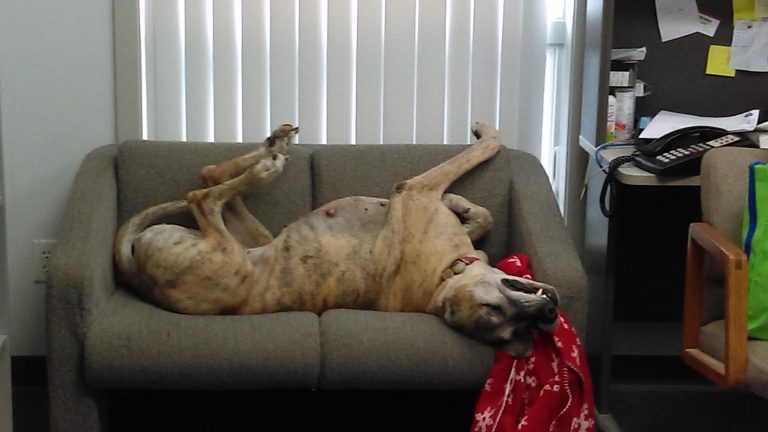 As our pets approach their senior years, things begin to change for them. Their vision and hearing can become impaired, weight can become an issue (too heavy or too thin), and their activity levels seem to slow down (often times due to arthritis or degenerative processes). From a rehab therapist’s perspective, it is very important to not let these changes negatively impact a pet’s mobility and independence if we can help it. Keeping our senior dogs on their feet and moving is one of the most important things an owner can do for the aging pet. Once an older dog (especially a larger one) goes down and decides that they do not want to get back up, it can a difficult situation for everyone. So how do we avoid this problem? Keep them healthy and moving! As our pets approach their senior years, things begin to change for them. Their vision and hearing can become impaired, weight can become an issue (too heavy or too thin), and their activity levels seem to slow down (often times due to arthritis or degenerative processes). From a rehab therapist’s perspective, it is very important to not let these changes negatively impact a pet’s mobility and independence if we can help it. Keeping our senior dogs on their feet and moving is one of the most important things an owner can do for the aging pet. Once an older dog (especially a larger one) goes down and decides that they do not want to get back up, it can a difficult situation for everyone. So how do we avoid this problem? Keep them healthy and moving!
Keep Them Moving!
Exercising a senior dog does not have to be complicated. If we keep in mind some basic goals and expectations, then we can turn a daily routine into an enjoyable home rehab therapy session. What should our goals be? To keep the geriatric pet up and moving at a level that is comfortable for them. Combining activities that challenge body awareness (Where are my feet?) and support strengthening are an ideal senior exercise plan. To put it in simple terms: older pets need to find a low intensity activity that engages their mind, gets them walking with changes in direction (circles and turns are important), and has them stepping over stuff.
Many of our older dogs still have a huge play drive and desire to go-go-go, but what we need to do as pet parents is to channel this energy into a more structured and controlled play time. It is better to be able to participate in that loved activity such as swimming or ball play for a shorter/less intense time every few days then to go all out with high-drive fun in a single day and then be sore for the next few days or weeks. On the other hand, some senior dogs could care less about going for that walk or being active. These pets are a challenge because we need to find what motivates them and then use it to encourage productive activity.
Things to Consider for Your Pet’s Senior Exercise Program
Keep time of active exercise so that you have an idea of the minimum amount of true activity that your pet is getting. Letting a pet out in the yard for 1 hour does not equal an hour of exercise. Dogs have a tendency to have a short burst of energy or play time and then spend the rest of the time sniffing, scratching, marking, and doing all of the other non-exercise dog stuff that dogs do.
Jazz up your walk: Sure you can continue to go around another block in a straight line on your flat road (because we all know Delaware is pretty flat). Instead, try to add in a few circles, zig-zags, or figure eights to your walk to challenge body awareness and engage different muscle groups. Find a park or trail that has it all: different terrain (grass, pavement, gravel), small incline and decline hills, tree roots or low ground obstacles to step over. If there are sidewalks or curbs around, have your dog step on and off them for some low intensity strengthening moves.
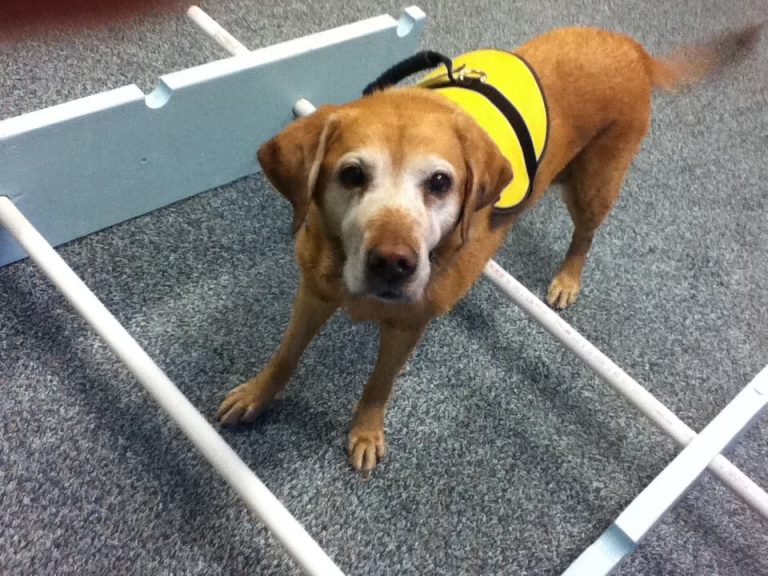 Lift Those Feet: Stepping over stuff is great for a pet’s body awareness and joint mobility. Lay a ladder on the grass and have your dog step over the rungs one foot at a time (avoid hopping with 2 feet). To increase the challenge, try back stepping or side stepping between rungs. Take advantage of the great outdoors and use tree roots or drainage spouts as something to step over. The only limitations are to have the dog step over one foot at a time and to have the object low enough to avoid jumping. Lift Those Feet: Stepping over stuff is great for a pet’s body awareness and joint mobility. Lay a ladder on the grass and have your dog step over the rungs one foot at a time (avoid hopping with 2 feet). To increase the challenge, try back stepping or side stepping between rungs. Take advantage of the great outdoors and use tree roots or drainage spouts as something to step over. The only limitations are to have the dog step over one foot at a time and to have the object low enough to avoid jumping.
Doggie Yoga Movements (Doga?): Strengthening or maintaining a pet’s core muscles is super important for mobility. A pet with a strong core can better manage a weaker hind end with less loss of function in day to day movements.
Single Leg Lifts- Start with the dog in a comfortable standing position with all four feet evenly spaced apart. Lift one leg at a time and hold for up to 10 seconds so that the pet is balancing on the remaining three legs. Work your way around the body if able and repeat 3-5 times for each leg.
Diagonal Leg Lifts- For a bigger challenge, lift the diagonal legs at the same time so that the dog is balancing their weight on the remaining set of diagonal legs (ex: lift left front and right rear at same time). Hold for up to 10 seconds or until the pet begins to sway or loose their balance.
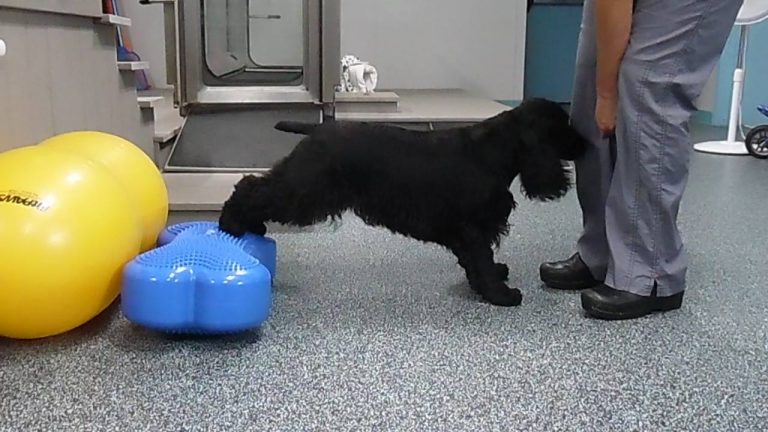 Leaning Forward While Standing- Begin with the pet standing with feet evenly spaced. Using a treat or toy, encourage the dog to lean or stretch forward ( their head should be neutral and not too low or arched high) while keeping their hind feet firmly placed. Hold this position for 10 seconds and repeat 3-5 times. In some pets you will get a better stretch if you place your hands in front of the hind legs to hold them in place while encouraging a farther reach forward. To add a challenge and engage the core even more, have the dog complete this exercise while standing on an air mattress or wobble board. Leaning Forward While Standing- Begin with the pet standing with feet evenly spaced. Using a treat or toy, encourage the dog to lean or stretch forward ( their head should be neutral and not too low or arched high) while keeping their hind feet firmly placed. Hold this position for 10 seconds and repeat 3-5 times. In some pets you will get a better stretch if you place your hands in front of the hind legs to hold them in place while encouraging a farther reach forward. To add a challenge and engage the core even more, have the dog complete this exercise while standing on an air mattress or wobble board.
Downward Dog (play bow)- If this is a trick or natural behavior that your senior pet knows then use it for a great spinal stretch. Using a treat or reward, encourage the bowing of the head and front limbs so that the upper body and elbows are stretched forward and down on the floor. The key is to have your pet hold this position for up to 10 seconds for the greatest benefit. Repeat 3-5 times.
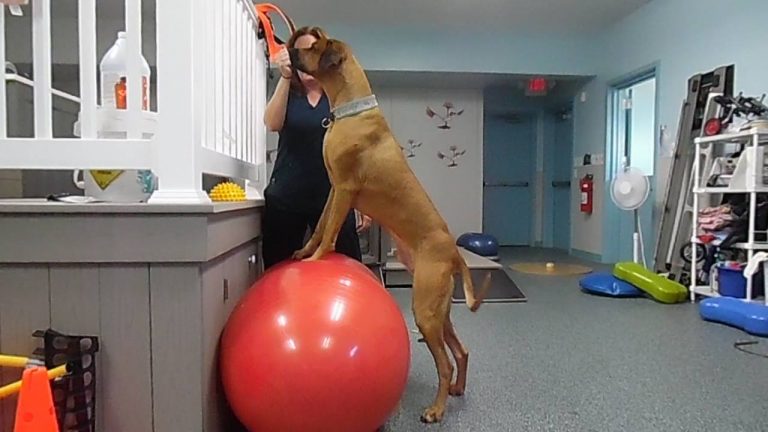 XPaws UP- How “up” the front (or hind) feet go will depend on the condition and size of the pet. Start by having the pet place their front feet on a stair tread or step and hold this position for 10 -15 seconds (if able). Remember to keep the head neutral and not too low or arched back looking for the treat or reward. To increase the challenge, use a chair or stair step that is further up. For the smaller dog, be creative and look for things in the house that may comfortably elevate the front feet to shift the weight to the hind end (a book or box?) XPaws UP- How “up” the front (or hind) feet go will depend on the condition and size of the pet. Start by having the pet place their front feet on a stair tread or step and hold this position for 10 -15 seconds (if able). Remember to keep the head neutral and not too low or arched back looking for the treat or reward. To increase the challenge, use a chair or stair step that is further up. For the smaller dog, be creative and look for things in the house that may comfortably elevate the front feet to shift the weight to the hind end (a book or box?)
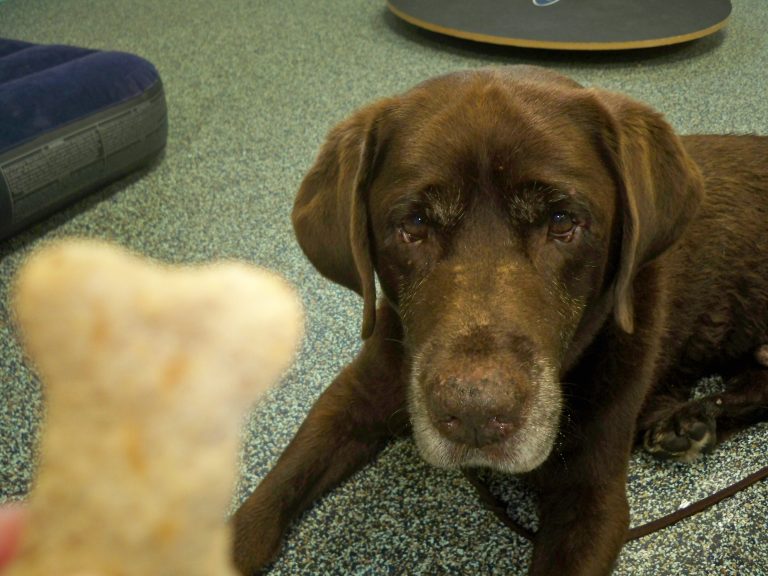 Mental Game Ideas: Remember the goal- to engage the mind and encourage focus. Be creative and don’t over think it. There are mind engaging games available commercially or with just a little creative ingenuity. Practice basic commands or some trick training (sit, stay and then recall, shake paw, roll over). There is the ever popular game of “find the treat” or “find the toy”. Is your older pet a retired sporting dog or competitive dog? Dust off the old training commands such as “heel”, “hold”, and “come” and use them as a game to engage your pet’s mind. Do you have a very uninterested and unmotivated dog? A real couch potato? Use what they love (a ball, food, affection) to get them to pay attention. The only rules are that this needs to be a positive experience with an activity that the pet will find success (avoid pet and owner frustration). Mental Game Ideas: Remember the goal- to engage the mind and encourage focus. Be creative and don’t over think it. There are mind engaging games available commercially or with just a little creative ingenuity. Practice basic commands or some trick training (sit, stay and then recall, shake paw, roll over). There is the ever popular game of “find the treat” or “find the toy”. Is your older pet a retired sporting dog or competitive dog? Dust off the old training commands such as “heel”, “hold”, and “come” and use them as a game to engage your pet’s mind. Do you have a very uninterested and unmotivated dog? A real couch potato? Use what they love (a ball, food, affection) to get them to pay attention. The only rules are that this needs to be a positive experience with an activity that the pet will find success (avoid pet and owner frustration).
These are just some starting exercises, a place to begin with your geriatric exercise journey. There are many ways to customize your program to better fit a senior pet’s life-stage and ability. Need a hand developing your program? Ask your local veterinarian or rehab professional for some input. The point to all of this is to just keep your older fur babies happy, healthy, and moving.
|